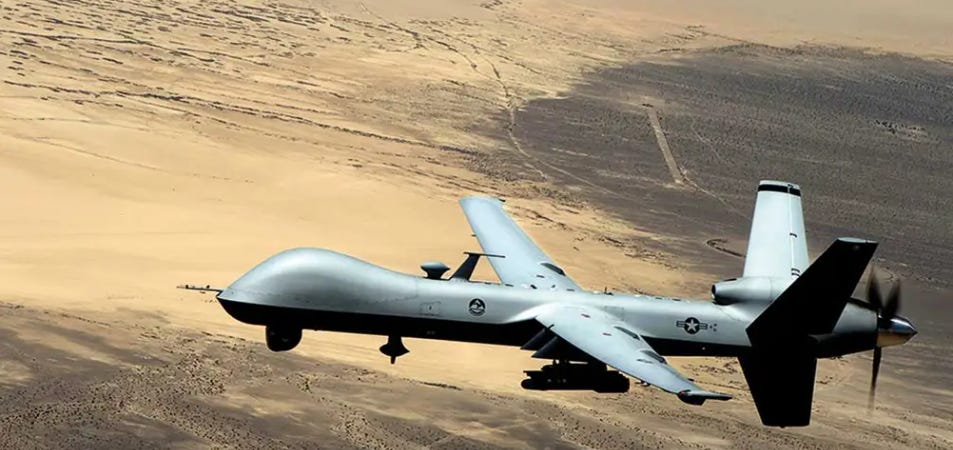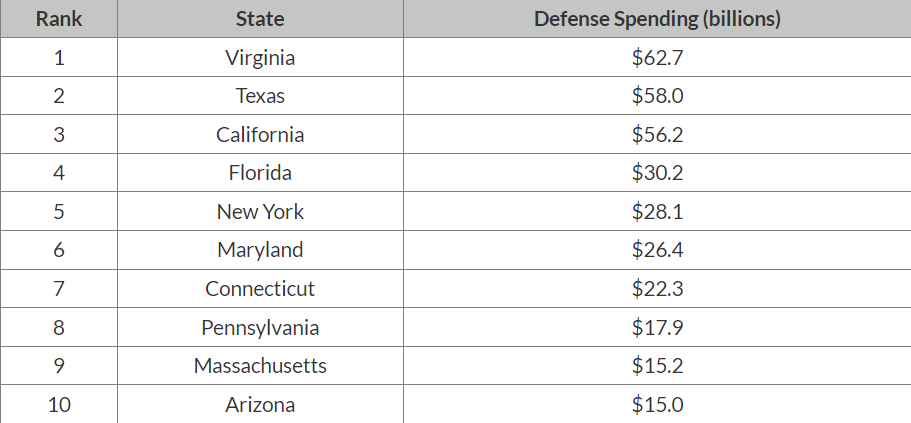We’re very close to war changing forever
Everyone is talking about the use of drones in the Russia/Ukraine war. While the US has been using advanced multi-million dollar drones for reconnaissance and targeted assassinations for decades (see below), the drones being employed in the aforementioned conflict are cheap and can be assembled en-masse by amateurs in garages. Here’s a video of one such drone following a Russian soldier and then self-destructing - killing the soldier. This drone is being remotely controlled and must therefore be captained by a soldier hiding somewhere nearby. Similar drones have been used to destroy tanks.
This tinkerer built a drone for $500 using open source software that didn’t need a pilot and which could be trained to automatically home in on people (generally) or even a specific person. Simply enter coordinates (latitude, longitude) and the drone will fly to that area, then it will seek out the first human it identifies and fly straight toward it. For an extra $1000-$2000 you can get a larger model and some explosives capable of killing a person, and attach a fuse and some sensors that will automatically detonate on contact.
Price moves inversely to production capacity - more capacity = lower price. Were the components of an iPhone today purchased separately back in 1990 the cost would be in excess of $3 million (mostly due to the compute/memory). Today the cost is $1,000.
Imagine what the front lines of the Russia/Ukraine conflict would look like if each side could drop 10,000 drones at a time - all of which are working in concert with one another. The drones can navigate themselves, enter into small crevices, and are capable of distinguishing between civilians and combatants. The 10,000 drones reach a certain altitude and then immediately spread out - looking for the nearest combatant and heading straight for them. Once they’re close enough to ensure a kill they self-destruct.
New defense mechanisms will have to be created. New jamming technologies, new anti-drone batteries, and who knows what else. Will they work? I don’t know, but people are already figuring out ways around the future defenses. It’s extremely difficult to attack 10,000 things at once. Ironically - the best defense may end up being drones.
Takeaways:
Drone prices will plummet and their role in war will become primary
War will get cheaper
Software (and AI) will become more impactful
It will be easier to avoid “forever wars” like Afghanistan b/c the guerilla techniques of the past will be harder to pull off
The US and China - already dominant - will pull so far ahead of the rest of the world that each would be able to end any conflict (if they so chose) in a matter of days
Anduril is <10 years away from being the largest (by valuation) defense company in the country, and is extremely undervalued at its recent $14B valuation
I’m on a waiting list hoping that an Anduril employee will decide to sell some stock (undoubtedly at a huge premium). I’d like to invest about $100k (not personally, but out of one of the portfolios I manage for family) - but unfortunately without a much larger interest you don’t get priority - so I’ll never have a shot unless a big stack of equity comes available.
I believe their recent $14B valuation - were you to have access - would end up resulting in a 10X+ return in 10 years. Why?
Because the entire defense industry has been operating on a cost+ model since inception. Let me explain why this is so poisonous.
If I asked three lawn companies for a quote to plant sod in my backyard each of them would attempt to provide a price competitive with the others (lower) b/c they wanted to win the business. Obviously, if there was only one lawn company in town b/c it had the sole license to operate then it would be able to charge far more. Still - a cap would exist on the price it could charge b/c at some point I’d be better off sticking with crabgrass, planting trees, or putting a bunch of pebbles back there.
Now consider the following. A new law is passed saying I MUST have sod in my backyard. There is only ONE company allowed to provide it. Worse still, the company doesn’t have to tell me what it’s going to cost - they simply inform me that the cost will be 10% higher than whatever it costs them to plant it. How high could my cost end up being? The limit is strictly theoretical. Here’s how much the lawn company would make under different scenarios:
Their cost: $100 - My price: $110 - their profit: $10
Their cost: $1,000 - My price: $1,100 - their profit: $100
Their cost: $1,000,000 - My price: $1,100,000 - their profit: $100,000
Their incentive is to charge as much as they possibly can. How do they maximize billings? Two ways:
Make it take a long time
Make the bill of materials as expensive as possible
In practice, it’s even worse - because much of their “cost” is simply corruption. Hiring people who don’t add any value (paying government “consultants”, retaining employees who haven’t added value in a decade, etc).
The defense industry is typically seen as one of the safest out there - on par with utilities. Why? Because their customer is the government (they literally refer to the government as “customer” on conference calls - which is hilarious). Neither democrats nor republicans have any interest in efficient military spending - their interest is in bringing as much economic activity to their respective geographies as possible. Politicians benefit from huge military budgets. If you ever wondered why military spending never seems to drop under democrats - this is the reason. Cutting defense spending means losing out on money flowing into an economy. The incentive is not to spend it efficiently - but to grab as many dollars as possible.
The good news is - despite the incestuous relationship between the highest echelons of the military and our government - there are still rules that govern the procurement process. IF a company can provide the obviously best solution to a problem (technology + cost) - they will likely win the contract.
While it takes years and many billions of dollars to develop fighter planes - this is not the case with drones (I’m including autonomous marine vessels as “drones”). Anduril has been winning government contracts and has many assets deployed already, including drones, autonomous marine vessels, sentry towers, and undoubtedly things we haven’t heard of due to them being classified.
The cost+ model is so obviously fucking stupid - how did it come to be a thing? The answer is World War II. At the time the government needed to get American industry to convert their factories from producing whatever they had been to making tanks, uniforms and everything else needed to wage a global war. Because those companies had no idea what it would cost and because time was of the essence, the government just told them to send them a bill for their costs and they’d pay them a profit on top. Things have been done the same way ever since.
Defense companies bill the government for their research and development expenses. Because they have no R&D “risk” (R&D is - on the contrary - a guaranteed profit center). In return for having no risk they only get to earn a fixed percent of profit (the cost+ model). Anduril on the other hand takes on the R&D risk - but isn’t subject to fixed profit margins. All it has to do is offer the best solution for the money.
The net result is that you have only one company in the defense space benefiting from capitalist dynamics - and it’s competing against a bunch of corrupt pseudo-government organizations whose primary skillset is figuring out how to be as inefficient as humanly possible (both in terms of time and raw material costs).
Anduril vs. the defense primes will be like Tesla vs. GM and Ford. They will have a monopoly on the best talent, and their incentives are to keep costs as low as possible and to innovate as quickly as possible.
My guess is Anduril will be the largest defense Prime within 10 years, and will be larger than all defense primes put together in 15-20.







American Dad taught me that nothing good can come from a kid that overstays his welcome at the teet (enter Steve, S15.E5 Tapped Out).
But seriously, the cost+ model has got to go and Anduril sounds like it's found a good niche to thrive in the defense space on free market mechanics. I totally agree with your argument.